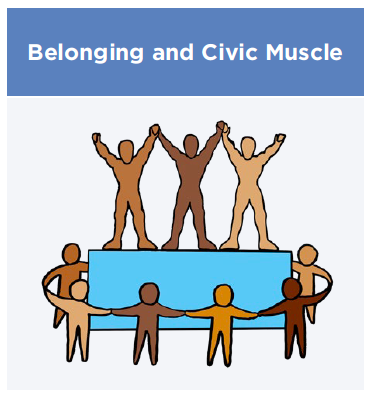The Stew BLOG
The Essential Components of a Comprehensive Transformation Strategy for Regional Health and Well-Being
In July, I celebrated my 44th birthday, which is significant because it means that I am nearly at the halfway mark between the start of my career and traditional retirement age. I’ve been reflecting on my future goals—where do I want to live after my children leave the nest? Where might I want to retire or live in old age? How much traveling do I want to do?
Thinking about these long-term goals naturally leads to questions about the mix of financial investments I need to make now to ensure the retirement I want for my future. I know, for example, that my financial portfolio should be diverse and responsive to current needs and conditions and also connected to my vision for my retirement. Similarly, when regional leaders are crafting a regional transformation strategy, they should be attentive to what they are trying to achieve and think through what activities and investments will get them there.
As my colleague Bobby Milstein stated in his recent blog post, in order to transform health, multiple organizations need to join together to create a comprehensive regional strategy that bridges myriad sectors and perspectives, taking into account the dynamic interplay occurring among the various stakeholders across the entire health system. What needs to be created, in fact, is a comprehensive strategy to transform the health ecosystem, considering all the sectors, institutions, and variables depending on and interacting with one another to produce health and well-being in a region.
Components of a Comprehensive Regional Strategy
A comprehensive regional strategy should have two components: (1) a credible theory of system change, which demonstrates how the various forces in a region interact to create health or disease and then explains how these forces will submit to or resist change over time if a particular set of actions takes place; and (2) a portfolio of interventions, which describes how leaders will achieve the change they seek through a selection of policies, programs, and investments.
A theory of system change is necessary to drive real change across the entire health ecosystem in a region, rather than tweaking at the margins within the confines of an individual organization or institution (the more typical and easier way of doing business). And to be more than just a theory, it must be backed up by the enactment of a portfolio that encompasses multiple interventions that focus on key leverage points—or places where making small shifts can have a great impact.
Creating a theory of system change first requires that organizations come together and agree on a shared vision of the future. For a theory to be effective, it must offer a credible way to achieve that vision, grounded in the group members’ collective values. It should also clearly show how multiple goals and trends can be addressed over time, rather than just listing a collection of programs or projects. Even when stakeholders have aligned around an ambitious vision for health in their region, it can be difficult for them to pursue more impactful strategies that will add up to the change they hope to see if they haven’t considered how the selected strategies interact with other components of the system. Taking the time to understand those interactions allows stakeholders in a region to build a stronger and more accurate theory.
Let’s take a look at how the Trenton Health Team (THT) came to articulate a new theory of system change that is helping to drive decisions that will have transformative effects.
A Theory of Change in Trenton, New Jersey
Trenton, New Jersey, was one of six communities selected in 2016 to participate in ReThink Health Ventures, an initiative designed to help regional multisector partnerships accelerate momentum to transform health in their regions. THT is a collaboration among two of the region’s major hospitals, Trenton’s federally qualified health center (FQHC), the city’s health department, and more than 60 community partners. For many years, THT has played a central role in pursuing Trenton’s vision to be the healthiest city in the state.
THT began nearly a decade ago with an organizational focus on access to urgent care services, but quickly discovered a need to broaden its strategy to include:
- Expanding access to primary care
- Improving care coordination and care management
- Operating a health information exchange to give providers shared access to patient data in real time
- Engaging the community to increase knowledge and overcome obstacles to care
- Functioning as one of the state’s three certified Medicaid accountable care organizations
But even this broadened strategy was not sufficient. Recently, when THT and its partners started working with ReThink Health and taking a systems view, it became clear that these strategies alone would not add up to the change they wanted to see in the region. Rather, articulating a transformation strategy for the region required that THT and its partners—who had previously focused on their individual organizational and institutional strategies—begin to consider a collective strategy for the region as a whole. In doing so, they recognized that there are many forces and many parties who shape the health and well-being of Trenton. This inspired THT to begin looking beyond the partners with whom it was already working to consider who else in Trenton needed to be engaged to uncover the leverage points for effective change.
At the same time, THT recognized the need for a strong theory of system change that would encompass all of the interdependencies being uncovered. Working together, THT, its partners, and a new set of stakeholders from across Trenton developed a theory for the region, characterized in this way: If we actively collaborate, we can make Trenton a safe and healthy place to live, grow, learn, and earn; and we can help everyone reach their full potential.
Articulating a region-wide theory of change helped THT understand the role it could most effectively play in the region. As a result, THT committed to being more deliberate about collaboratively addressing the community’s needs, deepening engagement across the region, and expanding beyond the region’s usual suspects in health care. THT became a connector in the regional health system, helping stakeholders gain a broader perspective (a more holistic, ecosystem view) and more awareness of what others are doing to improve health in the region.
As THT embraced its emerging role as a connector, its leaders were better able to see that too many of the region’s resources were focused on urgent needs in the community. There were a lot of interventions, such as homeless shelters and income support policies, that addressed immediate needs but only had limited potential to avoid these system failures for future generations.
To achieve their shared vision of transforming health of the region, the many partners and stakeholders working with THT recognized the need to focus more energy and resources on supporting the vital conditions that everyone depends on for health and well-being (such as stable housing, living wage jobs, and environmental quality), as well as Belonging and Civic Muscle, which is both a vital condition unto itself and a special capacity that is expressed through every other effort to support people’s health and well-being.
While more difficult to address, these types of changes would ultimately lessen the demand for urgent services. This new awareness caused the group to define a more specific theory of system change that now includes achieving a better balance between efforts to deliver urgent services, assure vital conditions, and strengthen belonging and civic muscle. (ReThink Health offers this tool to regional stewards interested in understanding their current portfolio and striking a better balance.)
![]()

Portfolio of Interventions for Trenton
With a detailed and refined theory of system change now in place, THT focused on honing a portfolio of multiple interventions for Trenton; one that expresses the actions that the region is taking to carry out its theory of system change.
A strong portfolio does not refer to the priorities of one organization. Rather, it includes the full range of activities, including policies and practices, being pursued across multiple organizations. It may be difficult at first to think more broadly about all the interventions being pursued across an entire region. It requires a real mindset shift that is essential to achieving a vision of regional health transformation. However, as organizations become more comfortable working together in new, collaborative, and interdependent ways, it gets easier to see how everyone’s efforts to address (and do not address) the leverage points identified in the theory of system change.
To help with this in Trenton, THT is actively developing its capacity to serve as a connector, or regional health hub, and to sustainably fund that work. What’s more, leaders from across the region are building their capacity to participate in collective decision making, strategic planning, and decisions about shared investments. So far, this is yielding great success. Those involved in Trenton’s transformation efforts are focusing beyond just health care in their portfolio of interventions and stakeholders are helping establish the vital conditions they know will build long-term health and well-being in the community.
For example, THT has been working with local partners through the BUILD Health Challenge to create a “Safe and Healthy Corridor” from the Battle Monument Park to Capital Health Regional Medical Center, an area of Trenton that includes schools, churches, and hospitals. The redevelopment will include a new primary care system, as well as lighting and sidewalk improvements, upgraded parks and green spaces, farmer’s markets, and community gardens—reflecting Trenton’s commitment to support both vital conditions and urgent services in the community. THT facilitated the collaborative proposal process for this initiative and continues to convene the key stakeholders to move this work forward.
In addition, THT is building on its previous work to establish a health information exchange for the region and is now exploring how data about social determinants, including environmental assessments and school attendance, might assist the city in making decisions and plans for the future. This work has been gaining traction; THT has become a statewide model and has used this distinction to advocate for state support of similar regional hubs to advance this work throughout New Jersey.
Are You Asking New Questions About What It Might Take to Develop A Comprehensive Strategy?
As exemplified in Trenton, even after regional collaborators agree on a vision for the future, the hard but critical work must continue with the development of a comprehensive strategy, including a theory of system change and portfolio of interventions. Over the course of this blog series, we’ll continue to explore what it takes to develop such a strategy and will provide an assessment tool that can help leaders like you, who aspire to transform their fragmented health systems, by asking themselves and their colleagues questions such as:
- Is it ambitious, aimed at making a real and lasting difference?
- Is it broad and comprehensive?
- Is it well-coordinated, or are there multiple, disconnected strategies?
- Is it focused on multiple aspects of health and well-being, not simply reducing costs or delivering better care?
- Is it inclusive, with a fair distribution of benefits and burdens?
In the meantime, we hope this series is encouraging you to begin asking questions about your current regional strategy. If you can answer yes to some or all of these questions, you are already well on your way to developing a comprehensive strategy! Let us know in the comments below what you are doing well, and where you are starting to think about changing up your approach. Or write us at [email protected].

